
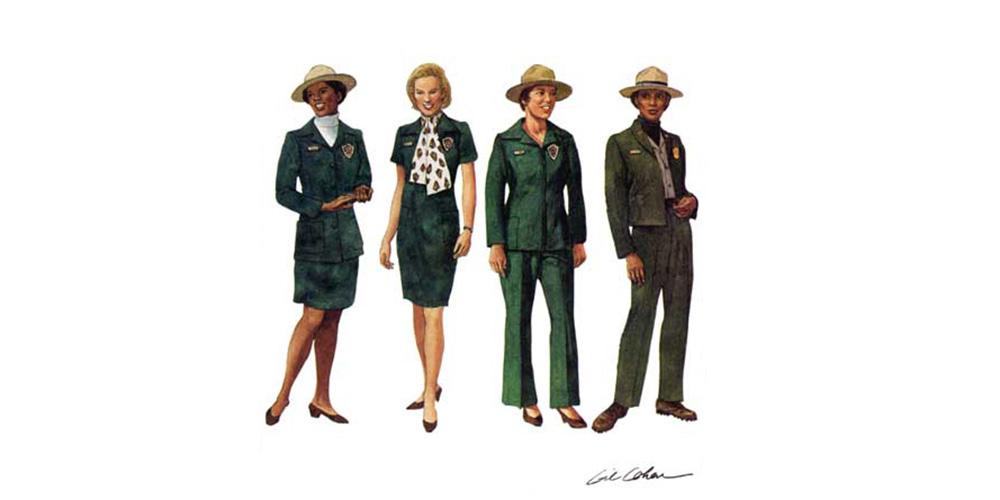
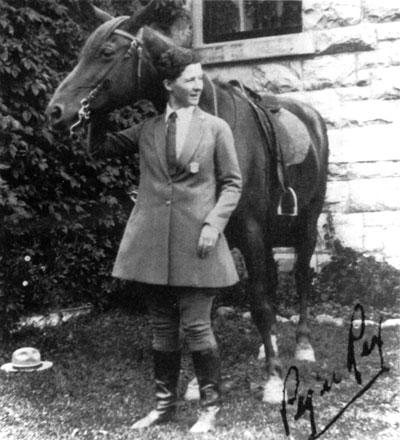 In the early days of the National Park Service, women were involved in a very limited capacity—as seasonal employees, temporary fill-ins, naturalists, or assistants to their ranger husbands. As a result, their “uniforms”—if they had any—were improvised. Some adapted the men’s uniform, tailored for a woman (1). Others cobbled together a uniform of their own design (2).
In the early days of the National Park Service, women were involved in a very limited capacity—as seasonal employees, temporary fill-ins, naturalists, or assistants to their ranger husbands. As a result, their “uniforms”—if they had any—were improvised. Some adapted the men’s uniform, tailored for a woman (1). Others cobbled together a uniform of their own design (2).

A big step toward standardization was the incorporation of Carlsbad Caverns into the National Park Service. Women worked as guides in the caverns, and they were outfitted with a uniform (4). Every park was different, however, and a variety of styles could be seen through the 1930s (3).
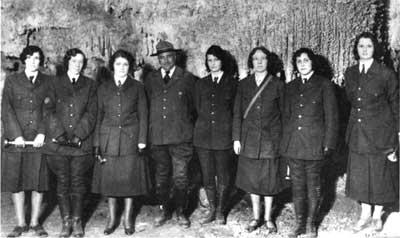 In fall 1941, a committee of women was assembled to consider the uniform issue. But the U.S. was plunged into World War II with the attack on Pearl Harbor that year, and the matter was tabled.
In fall 1941, a committee of women was assembled to consider the uniform issue. But the U.S. was plunged into World War II with the attack on Pearl Harbor that year, and the matter was tabled.
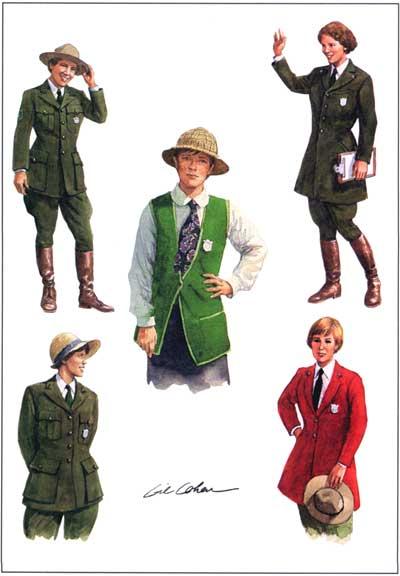 It wasn’t until June 1947 that a standard uniform for women was authorized (and then only under the segregated “Special Uniforms” section of the official policy). But, at last, there was progress toward recognizing women as a full member of the NPS establishment (5). The uniform was an adaptation of the militaristic Women’s Auxiliary Army Corps (WAAC) blouse, and women complemented the look with the fashionable Army “overseas” cap (6).
It wasn’t until June 1947 that a standard uniform for women was authorized (and then only under the segregated “Special Uniforms” section of the official policy). But, at last, there was progress toward recognizing women as a full member of the NPS establishment (5). The uniform was an adaptation of the militaristic Women’s Auxiliary Army Corps (WAAC) blouse, and women complemented the look with the fashionable Army “overseas” cap (6).
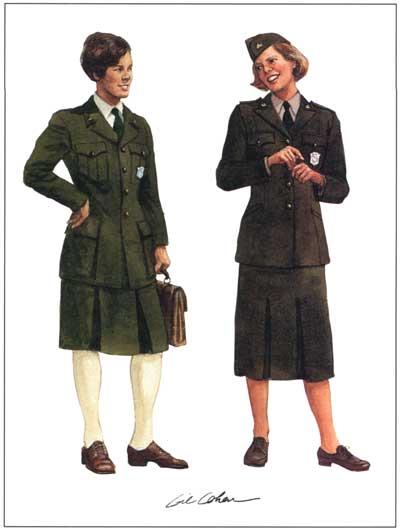 The next phase in the evolution took place in 1961, when new regulations went into effect. This was the dawn of the “airline stewardess” epoch, as the new uniform was modeled after those worn by American Airlines flight attendants (7) (8).
The next phase in the evolution took place in 1961, when new regulations went into effect. This was the dawn of the “airline stewardess” epoch, as the new uniform was modeled after those worn by American Airlines flight attendants (7) (8).
 In a way, the look—which pigeonholed women for a certain type of “feminine” work—reflected a written statement issued by the NPS in 1960, noting that while the agency should “employ in its uniformed positions the best qualified men and women available...women cannot be employed in certain jobs, such as Park Ranger or Seasonal Park Ranger...in which the employee is subject to be called to fight fires, take part in rescue operations, or do other strenuous or hazardous work....”
In a way, the look—which pigeonholed women for a certain type of “feminine” work—reflected a written statement issued by the NPS in 1960, noting that while the agency should “employ in its uniformed positions the best qualified men and women available...women cannot be employed in certain jobs, such as Park Ranger or Seasonal Park Ranger...in which the employee is subject to be called to fight fires, take part in rescue operations, or do other strenuous or hazardous work....”
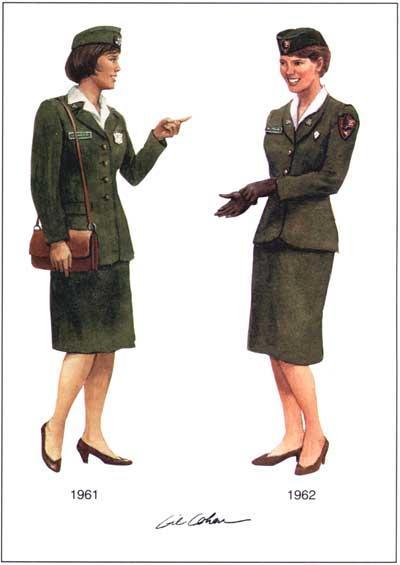 Furthermore, at certain parks, women were not authorized to wear the official NPS badge. Instead, they were issued a “silver arrowhead pin” the size of a tie tack—“in lieu of badge” (9).
Furthermore, at certain parks, women were not authorized to wear the official NPS badge. Instead, they were issued a “silver arrowhead pin” the size of a tie tack—“in lieu of badge” (9).
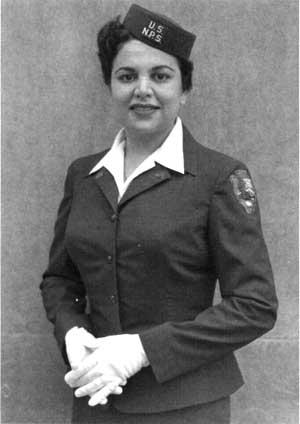 The “stewardess” uniform proved to be limited in its utility for the range of functions that women performed in the Park Service, and many expressed their frustration. Its redesign was made a priority for the 1968 Uniform Committee.
The “stewardess” uniform proved to be limited in its utility for the range of functions that women performed in the Park Service, and many expressed their frustration. Its redesign was made a priority for the 1968 Uniform Committee.
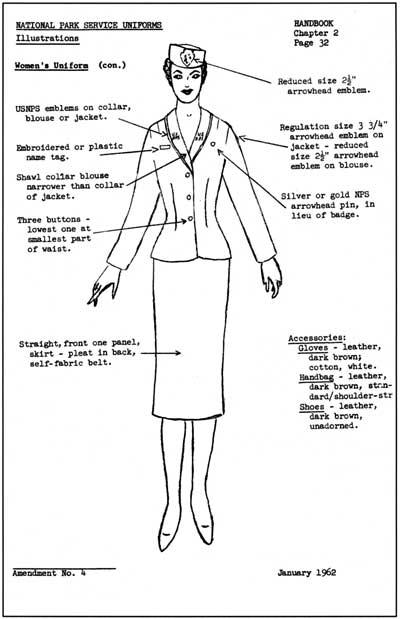 The NPS consulted experts, led a fact-finding mission to survey women across the NPS, and convened a “think tank” of women in Washington, D.C. A brand-new look was introduced in early 1970, and enthusiastically approved soon after (10). The radically altered uniforms made their first public appearance at a “Grand Unveiling” in June (11).
The NPS consulted experts, led a fact-finding mission to survey women across the NPS, and convened a “think tank” of women in Washington, D.C. A brand-new look was introduced in early 1970, and enthusiastically approved soon after (10). The radically altered uniforms made their first public appearance at a “Grand Unveiling” in June (11).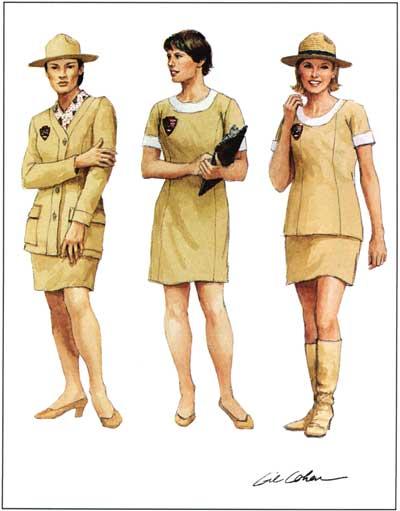
After the initial excitement, women in the field soon found the new uniforms to be more style than substance (12). The material and design simply didn’t hold up when it came to dealing with a brush fire, offering protection from the elements—or even physically supporting a badge.
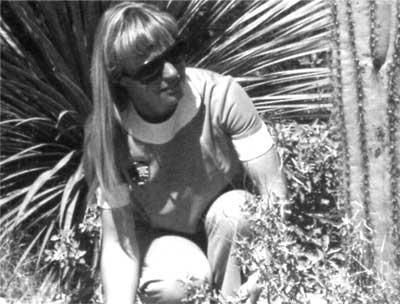 Renegade attempts at various parks to offer more practical attire—as well as complaints and even resignations over the uniform—led to another series of redesigned uniforms, which appeared in 1974 (13).
Renegade attempts at various parks to offer more practical attire—as well as complaints and even resignations over the uniform—led to another series of redesigned uniforms, which appeared in 1974 (13).
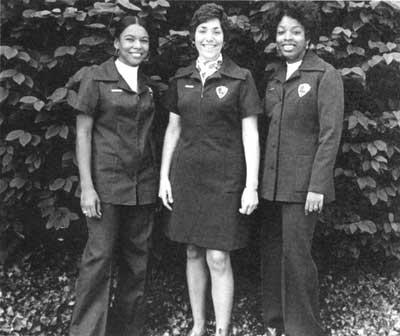 Three lines were developed, and the “A line” was derided as the “McDonald’s” uniform, for its similarities with the uniforms at fast-food establishments (14). But another one presaged the future; the “Women’s Traditional Uniform” was essentially the same as the standard men’s uniform—and represented a major breakthrough for the treatment of women as full equals with men (15) (16).
Three lines were developed, and the “A line” was derided as the “McDonald’s” uniform, for its similarities with the uniforms at fast-food establishments (14). But another one presaged the future; the “Women’s Traditional Uniform” was essentially the same as the standard men’s uniform—and represented a major breakthrough for the treatment of women as full equals with men (15) (16).
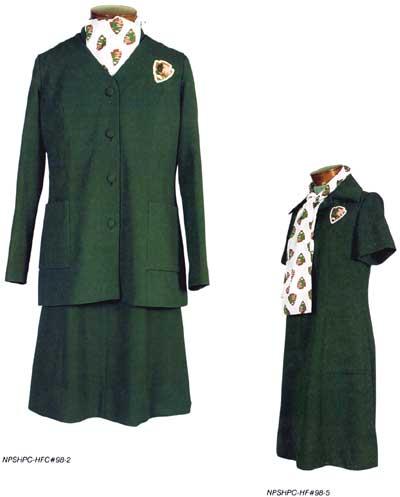 Finally, in spring 1978, the National Park Service authorized women to wear the same “green and gray”—in all its forms—as their male counterparts (including the badge!).
Finally, in spring 1978, the National Park Service authorized women to wear the same “green and gray”—in all its forms—as their male counterparts (including the badge!).
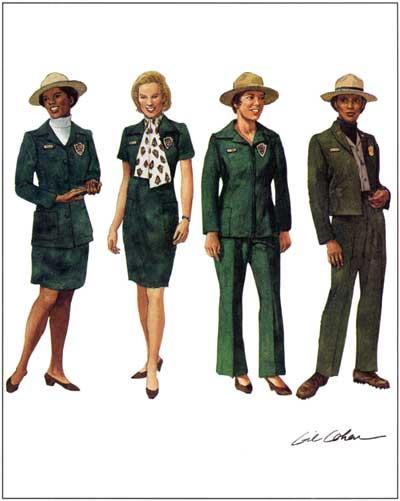 There were some differences, of course, in the women’s line of uniforms. For example, a maternity “jumper” or maternity top (17), and the option to wear a skirt. Today, as it was when the option was first officially sanctioned, the vast majority of women prefer to wear pants (18).
There were some differences, of course, in the women’s line of uniforms. For example, a maternity “jumper” or maternity top (17), and the option to wear a skirt. Today, as it was when the option was first officially sanctioned, the vast majority of women prefer to wear pants (18).
Note: Images and information culled from an extensive online book issued by the National Park Service.
National Park Service History Collection. Office of Library, Archives and Graphics Research. National Park Service Uniforms: Breeches, Blouses, and Skirts, 1918-1991. Vol. 4. Harpers Ferry, VA: Harpers Ferry Center, 1998. Online book: https://www.nps.gov/parkhistory/online_books/workman4/.
Photo Details
- Marguerite "Peg" Lindsley, c. 1925. Naturalist, Yellowstone National Park.
Peg was the daughter of Chester A. Lindsley, acting superintendent, Yellowstone National Park, 1916-1919, and the first permanent female naturalist in National Park Service. Peg and her horse Rex. Lindsley is wearing her tailor-made forestry-green whipcord uniform blouse and jodphurs, with riding boots, Stetson (seen lying on the ground), a green tie, badge and USNPS collar ornaments NPSHPC-HFC/93-326. - Frances Pound, 1925, Yellowstone National Park.
Pound was another child of the parks, growing up and sometimes patrolling with her ranger father, before joining the service herself. Here is another case where, due to the lack of uniform regulations covering women, the ranger was left to her own devices. Her knee length coat with slash pockets is undoubtedly of the standard forest green material. For decoration. she has a badge, sleeve brassard, and a pair of collar ornaments at the points of her lapels NPSHPC-YELL/130,375 - Guides at Carlsbad Caverns National Park, 1932.
These women were classified as guides, although one (second from left) is wearing a ranger brassard. Most images of women in Park Service uniform from this period were taken at this site, due to the number employed there. Thomas Boles, superintendent, (1927-1946) is standing in the center. NPSHC/CACA#7493A - Due to the lack of official guidance, early Park Service women wore whatever the park superintendent or their own whim dictated.
Badges were pinned on all types of clothing to identify their association with the Park Service. NPSART-Gilbert B. Cohen, artist-HFC/ARM#GR-0002 1 thru 5 - Women's dress, 1930s & 1940s
Women's uniforms began to become standardized when Carlsbad Caverns National Park and its uniformed women guides came into the fold, but the first official regulations pertaining to women were not issued until 1947. - Uniform for Women Employees, 1947 Uniform Regulations - Amendment No. 5, May 1950.
This image of Olive Johnson wearing a modified style WAAC Army uniform was used to illustrate the women's uniform in the Amended 1947 NPS Uniform Regulations. Even though the "overseas" cap was not addressed in the regulations, it was being worn by the women and thus, included in this picture. NPSHPC/HFC#96-1326 - Women's uniforms in the 1960s.
The 1961 pattern uniform was authorized in the 1959 Uniform Regulations, but was not to become effective until January 1,1961, but more than likely, anyone purchasing a uniform in 1960 ordered the new pattern. For some unexplained reason, the uniform was changed again in 1962. The material and color remained the same so the effect was minimal. NPSART-Gilbert B. Cohen, artist HFC/ARM#GR-0002-6, -7 - Camille Elias, c.1963.
Elias is wearing the 1961 "airline stewardess" style woman's uniform. The USNPS insignia was embroidered on a piece of material, then sewn on hat. She is also wearing the Large Arrowhead patch on her coat which wasn't authorized for women until 1962. A lot of women had purchased new uniforms prior and during the new regulation period (1960-1961) and like their male counterparts, were allowed to wear them as long as they were serviceable, and since their duties were less strenuous, some lasted a very long time. Her hat is the second version (" Buffalo chip") that came out just before the uniform change in 1962. Many women updated their old hats by removing the USNPS and replacing it with the small Arrowhead patch. NPSHPC - HFC#WASO G.337A - Illustration from the 1962 National Park Service Uniform Handbook showing the second "Airline Stewardess" uniform.
Chapter 2, page 32 National Park Service Archives/HFC RG Y55 - The 1970 uniform regulations pertaining to women brought forth a plethora of uniforms.
Not only did the female rangers now have their own distinctive dress for formal occasions, but for the first time there was a whole range of other clothing for their different functions. NPSART - Gilbert B. Cohen, artist - HFC/ARM#GR-0002- 8 thru 10 - Marion Riggs, Philadelphia, 1970.
Riggs, now Durham, is wearing the tunic with culottes and "Go-Go" boots at the Freedom Week unveiling of the new women's uniforms at Independence National Historical Park, Philadelphia, Pennsylvania, June 27, 1970. The regulations simply classified the footware as boots, but they quickly acquired the appellate of "GO-GO" because they resembled those worn by the exotic dancers of the period. There weren't enough of the new lightweight felt women's hats for all the models, so she borrowed a summer straw hat from one of the men rangers. NPSHPC - Cecil W. Stoughton photo - HFC# 70-253-96 - They proved to be totally inadequate for duties that required the ranger to work off the beaten path among the flora of the park, as Birdie Richards is doing here at Saguaro National Park in 1974. NPSHPC - Fred Mang, Jr photo - HFC#74-1593-2
- Three of the new 1974 green polyester women's uniforms.
Left to right: Roselyn Grey - white turtle neck, tunic and pants; Linda Balatti - scarf with dress; Marsha Wood - white turtle neck, jacket and pants. NPSHPC - Clare C. Ralston photo - HFC#75-2097-25 - 1974 women's Class 'A' uniform, with and without jacket.
NPSHPC - HFC#98-2 (left) and NPSHPC - HF#98-5 (right) - The 1974 uniform regulations brought forth the fourth uniform change for women in fourteen years, negating their clothing allowance "catch-up" factor. However, along with the "MacDonalds" uniform was one that harbingered things to come. One based on the men's style of uniform.
NPSART - Gilbert B. Cohen, artist - HFC/ARM#GR-0002- 11 thru 14 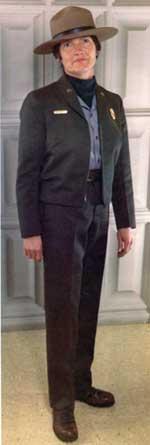 Marjoie M. "Mike" Hackett, superintendent, Fort Point National Historic Site, 1976. Hackett is wearing what some people consider the most attractive uniform designed for women in the Park Service, the "Woman's Traditional Uniform" authorized in 1974. She also has on the short jacket, sans pockets which appears to have been the standard coat for women. This jacket is often called the "Ike Jacket", attributed to General, later President Eisenhower, but that jacket has large breast pockets and didn't come into being until later. She is also wearing the black turtleneck in lieu of a tie.
Marjoie M. "Mike" Hackett, superintendent, Fort Point National Historic Site, 1976. Hackett is wearing what some people consider the most attractive uniform designed for women in the Park Service, the "Woman's Traditional Uniform" authorized in 1974. She also has on the short jacket, sans pockets which appears to have been the standard coat for women. This jacket is often called the "Ike Jacket", attributed to General, later President Eisenhower, but that jacket has large breast pockets and didn't come into being until later. She is also wearing the black turtleneck in lieu of a tie.
NPSHPC/HFC#76-80-3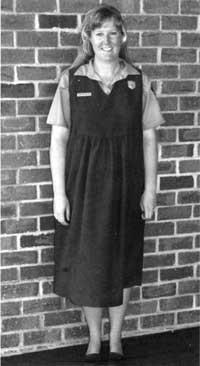 Dawn Baumstark, Fort Sumter National Monument, 22 May, 1995. Baumstark is wearing a new maternity "Jumper" and shirt. This is just one of the several styles of new maternity uniforms available to women now. NPSHPC - R. Bryce Workman photo - HFC#98-7
Dawn Baumstark, Fort Sumter National Monument, 22 May, 1995. Baumstark is wearing a new maternity "Jumper" and shirt. This is just one of the several styles of new maternity uniforms available to women now. NPSHPC - R. Bryce Workman photo - HFC#98-7